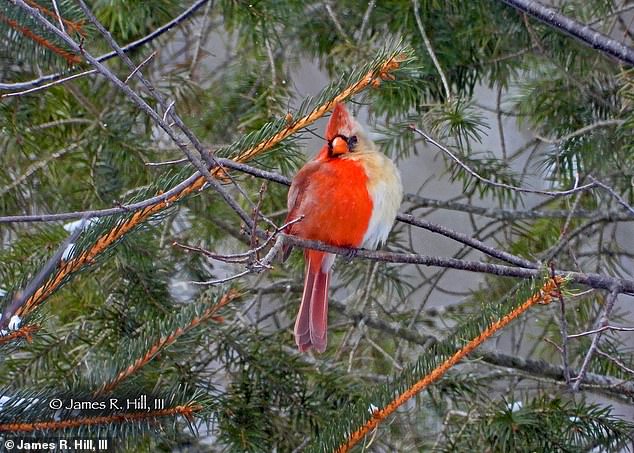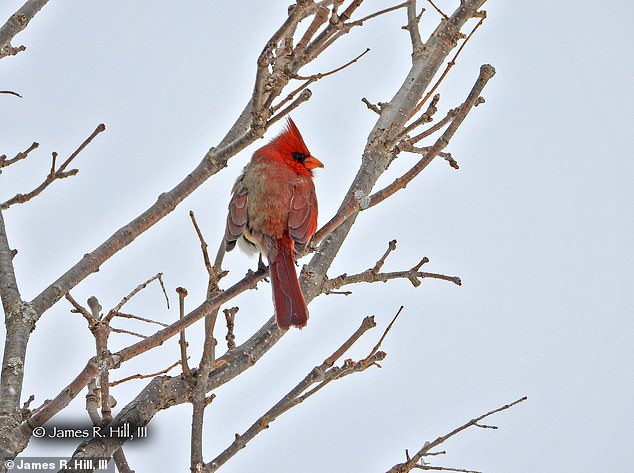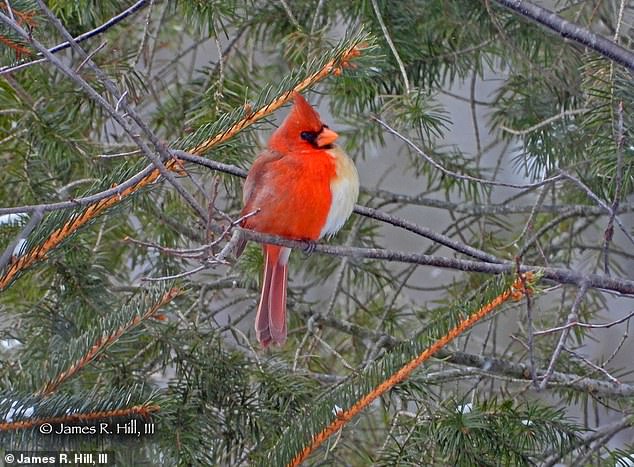A Pennsylvania bird watcher had what he calls a ‘once-in-a-lifetime’ encounter when a Northern cardinal perched in a tree appeared to be both male and female.
James R. Hill III has marveled at the feathered animals for 48 years, but on Saturday he saw a ‘one in a million’ bird with bright red like a male cardinal on one side and brownish white like a female on the other.
Hill describes the rare cardinal as ‘a bird divided right down the middle, half male and half female’ that stood out as ‘pretty unusual.’
Its striking appearance is the result of double fertilization, in which a female egg cell that developed with two nuclei is fertilized by two sperm.
The result is what’s known as a bilateral gynandromorph, where the bird appears to be a male and female stitched together.
Scroll down for video

A Pennsylvania bird watcher had what he calls a ‘once-in-a-lifetime’ bird encounter when a Northern cardinal appeared to be both male and female perched in a tree
Hill was notified by a friend about an unusual bird visiting feeders outside a home near Grand Valley, Pennsylvania ‘that was half one species and half another.’
‘This really piqued my interest since I wasn’t sure if she was referring to a hybrid, or a much rarer gynandromorphic bird (a bird that is ½ male and ½ female),’ Hill shared in a Facebook post.
‘We immediately tracked down the homeowner by phone and were told it was a male Northern Cardinal that ‘had some white on its breast.’ Ah, I thought maybe it was leucistic, which means it has some albinistic feathering.’
Cardinals are perching songbirds found in North and South America.

Its striking appearance is the result of double fertilization, in which a female egg cell that developed with two nuclei is fertilized by two sperm

Cardinals are best known for their bright red coloring, but this feature is specific to males. James R. Hill III has been an avid bird watcher for 48 years, but spotted the one in a million cardinal over the weekend. Female cardinals, on the other hand, have a much duller appearance
Cardinals are best known for their bright red coloring, but this feature is specific to males.

James R. Hill III has been an avid bird watcher for 48 years, but spotted the one in a million cardinal over the weekend
Female cardinals, on the other hand, have a much duller appearance.
This bird is one that does not migrate during the winter months, which is why Hill was able to capture stunning images of the rare creature.
When Hill saw the cardinal he knew immediately that it was not a leucistic bird, but one with bilateral gynandromorphism.
‘During our 1-hour stay, the bird came to the feeders only once (with 5 other cardinals), but thankfully it perched out in the open briefly in two other trees and I was able to shoot about 50 images,’ he shared in the Facebook post.

The result is what’s known as a bilateral gynandromorph, where the bird appears to be a male and female stitched together

Hill described it as ‘a bird divided right down the middle, half male and half female’ that stood out as ‘pretty unusual’
What is gynandromorph?
A cardinal spotted recently in Pennsylvania that appears to be half-male and half-female has shed light on the phenomenon of gynandromorphs.
They’re not all that uncommon in the wild, though the coloration or markings of some species make the results more striking than others.
A gynandromorph is an organism that has both male and female characteristics – or, a male-female chimera.
It’s often seen in insects, though gynandromorph birds, snakes, and other animals have been observed too.
Advertisement
Hill also notes a couple living 60 miles away near Erie, Pennsylvania observed a similar cardinal.
Jeffrey and Shirley Caldwell snapped image of the stunning feathered creature, which were published in National Geographic and other bird enthusiast magazines.
However, this led Hill to wonder if the bird seen in 2019 is the same one that perched in Green Valley.
‘Could this bird be the same individual as the Erie, PA, bird? Possibly — their bird was female on the left and male on the right, too,’ he shared.
‘The condition can be the other way around, with male left and female right.’
Gynandromorphs are uncommon, but not unheard of.
Dr. Daniel Hooper, who was a postdoctoral fellow at the Cornell Lab of Ornithology in 2019 and who was contacted by National Geographic, said: ‘They likely occur across all species of birds, but we’re only likely to notice them in species where the adult males and females look distinct from each other, a trait known as sexual dimorphism.’
‘Cardinals are one of the most well-known sexually dimorphic birds in North America — their bright red plumage in males is iconic [with females being buffy brownish] — so people easily notice when they look different.’
Source link : https://www.dailymail.co.uk/sciencetech/article-9295295/Pennsylvania-bird-watcher-spots-stunning-rare-cardinal-half-male-half-female.html












